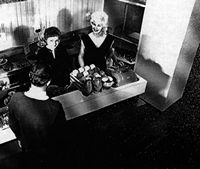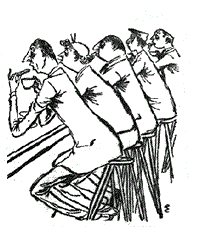[Requires Realplayer]
Click on images for enlargements and sources
Coffee, coffee everywhere: cafés in Wellington 1950–1990
by Peter Attwell
In the late 1950s and through the 1960s coffee bars sprang up all over
Wellington city, with names like La Scala, the Picasso, Sans Souci Coffee
Shoppe, Tete a Tete, and the International Coffee Lounge run by Wellington
celebrity Carmen. In those days the long established tea rooms closed
in the afternoons, the pubs (very much a male domain) at six o'clock,
and the restaurants, which served a narrow range of meals, generally closed
by 10 pm and couldn't serve liquor. There had been one or two coffee houses
in Wellington from the 1940s, such as the French Maid in Lambton Quay,
established by A. D. Singleton. Fagg's Coffee Roasters sold coffee beans
and ground coffee to the small home market, made up largely of new immigrants
who rejected with distaste the coffee and chicory essence that New Zealanders
called coffee. But the explosion of coffee houses from the late fifties
was to change all that, and change New Zealanders' life styles as well.
These new coffee bars filled a social gap, opening during the day to
cater for office workers, city shoppers and university students but, more
importantly, remaining open through to the early hours of the morning.
It became 'the thing to do' to go to a coffee bar after the pictures.
These were places to talk or read the newspaper, to pursue romances, or
just to watch and listen to others. The air was usually thick with cigarette
smoke in an era when most people smoked unaware of the dangers.
The lighting was dim in these coffee bars, and the walls often featured
posters of bull fighting or scenes of European cities. Fishing nets, floats
and driftwood were also used to create atmosphere. The furniture was usually
sparse: small formica tables, cane chairs, and some bar stools. There
was no effort to establish a distinctly New Zealand ambience; the look
was pseudo-European or at least foreign, and therefore sophisticated.
The coffee was generally of the Cona type, bubbling away in glass bowls,
or perhaps instant coffee, which had recently arrived on the New Zealand
market. A few of Wellington's coffee houses gave pride of place to one
of the new types of Italian espresso machines. These operated with a lever
like a beer pump and were somewhat unreliable, but the sound effects were
impressive and an additional spice of danger came from the rumour that
they sometimes blew up!
Whichever coffee shop you visited, you could obtain at reasonable cost
a light meal, toasted sandwiches, or some fancy cakes; indeed the food
was a big part of the appeal of these establishments. And if you were
smart and knew where to go, you could get your coffee laced with rum or
some other liquor. The Monde Marie in Roxburgh Street was one such establishment,
and its proprietor Mary Seddon battled unsuccessfully for years to get
a licence to sell wine at her coffee shop.
The coffee houses offered a range of new atttractions: the Mexicali and
the Sorrento were two establishments prosecuted by the city council for
allowing dancing on their premises on Sunday, the day of rest. The Casa
Fontana in Victoria Street broke new ground by featuring live jazz concerts.
Touring overseas artists like Theodore Bikel and Tom Lehrer sang at the
Monde Marie, as did New Zealanders such as Peter Cape, writer of the quintessential
Kiwi song 'Down the Hall on Saturday Night'. Down the road at the Chez
Paree coffee bar, patrons entered through a fake cave to sit and listen
to local renditions of the latest folk songs.
By the end of the 1960s there were more than 60 coffee shops, bars or
lounges in the central Wellington area, yet within a few years they began
to disappear. New Zealand society was changing. The advent of television
in the early sixties was one major influence, as people stayed home in
the evenings addicted to 'the box'. Another factor was the relaxing of
the liquor laws after a referendum in 1967, with hotels now able to remain
open until 10 pm in the evenings and serve food.
Ironically, the success of the coffee shops contributed to their own
demise. The simple but varied meals they offered helped New Zealanders
acquire a taste for something more than steak and chips or ham salad.
Restaurants with a more sophisticated international cuisine began opening
in the 1970s. These restaurants could also stay open late and they appealed
to a new, more affluent and well-travelled generation.
From the seventies the first wave of coffee bars began to wane and they
closed one by one. Typical was the Renown Coffee Lounge in Lambton Quay.
It was originally a milk bar opened in the 1930s, then a coffee lounge,
but in 1992, as the last such establishment in one of Wellington's busiest
streets, it finally closed. In a sign of changing times, it would be replaced
by a deli/café providing sit-down and takeaway service, with specialty
breads, salads and espresso coffee. Another wave of café culture had
begun.
The first coffee bars
Filling a social gap
The décor was different, and the coffee...
Food (and drink)
Entertainment
Art and literature
Harry Seresin's coffee house above Parson's Bookshop in Lambton Quay was
a focal point for writers, poets, artists, musicians and academics. Located
on a mezzanine floor in Massey House, Wellington's first high-rise building,
it had a stylish décor which reflected the owner's European background,
with original art works on display and classical music playing softly in
the background. Many of these coffee shops were started by European immigrants
like the German-born Seresin (who later opened the Settlement in Willis
Street featuring poetry readings, art exhibitions and a resident potter)
and Dutch woman Suzy van der Kwast, whose coffee shop in Willis Street introduced
New Zealanders to exotic new food such as smorgasbord lunches, carrot cake,
Dutch apple flaps and cheesecakes.
The beginning of the end
An end and a new beginning


